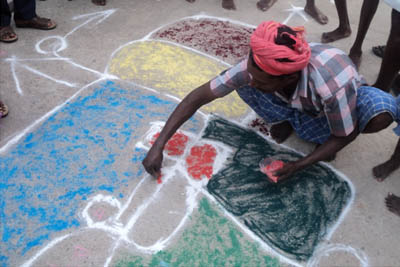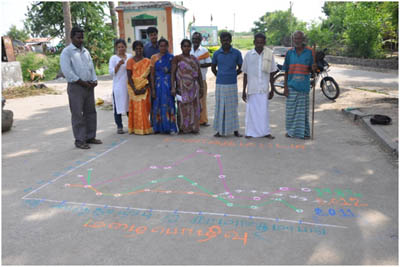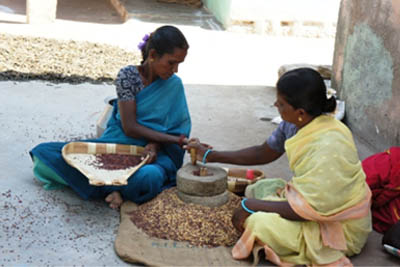Issue : 1 Article : 10
Communities Self-Assessing Resilience
R. Adhinarayanan, Programme Leader, DHAN Foundation, India, aadhi@dhan.org
Introduction
Agricultural Biodiversity Community’s (ABC) working group on resilience has developed a tool and process for communities to reflect on/assess resilience in agricultural biodiversity contexts. As part of resilience working group, DHAN Foundation has attempted a trial on climate change adaptation in rainfed farming project implemented area. This report shares the experience in the process of Communities Self-Assessing Resilience (CSAR)and learning from the exercise for further value addition/refinement of the tool. The trial was attempted to document resilience self-assessment by communities on rainfed farming system in T.Kallupatti block of Madurai district in Tamil Nadu state of India.
Location
The project is being implemented in four panchayats (Kilankulam, Salichandai, P.Ammapatti, and Chokkampatti) of T.Kallupatti block of Madurai district in Tamil Nadu province, India. These villages are five kilometres away from T.Kallupatti, a block headquarter town and 45 kilometres away from Madurai district capital. A total of 755 families reside in this area and the total cultivable area of our pilot project is 1080.58 hectare, in which 52.58 hectare comes under tankfed irrigated agriculture and remaining1028 hectare of land is pure rainfed.
Non-climatic stresses are as follows:
• Poverty due to less availability of employment
• School dropout of female children and literacy upto HSc among male students
• Shortage of drinking water
Current climatic stresses are as follows:
• Vagaries of monsoon (early/late onset and withdrawal on monsoon – not able to predict and practise their traditional seasonality)
• Increasing trend of temperature in summer
Community representation/Participants
Farming communities from eight villages participated in the resilience self-assessment. Totally,24 persons (three per village) represented the village climate change adaptation committee. The participants consisted of small-holder farmers, shepherds, and women farmers having an experience of 25 to 60 years in rainfed farming. Karuppiahaged 75 years old and having knowledge of about 60 years in agriculture was present at the forum.
Process of CSAR
The community members gathered in a community hall at Killankulam village which is centre for all the villages and is close to the agricultural fields. The process was facilitated by two facilitators (DHANites) who have worked with them for the last four years in the location.
Creation of shared understanding
The community members introduced themselves and the facilitators explained the purpose of CSAR. The meaning of resilience in vernacular language was discussed and the communities themselves defined the meaning of resilience with different examples.
Guruvammal from Kilankulam village defined it as follows:
Resilience is like a weed in our farm. The weed can survive in any climate change like excess or deficit rainfall, resistant to pest and diseases and it completes it life to produce seed for next generation with its own adaptation to expected and unexpected changes. Like this, in farming with different combination of activities and using knowledge gained over the years, successful crop should be harvested even in extreme events faced by the region with the adaptive capacity.
This definition was further discussed by the communities and everybody accepted it with a few changes. This process took half an hour to get shared understanding and it became base for the CSAR process. Following this, indicators for resilience were identified by the communities in rainfed farming. Also, the communities prepared a farm diversity map and visited fields to explain the same and exchange the best practices within their region. Also, the communities discussed the cropping season and its change over the last few years and how the communities adapt to the change of season (pattammattram).
With this discussion, the communities identified the drivers or attributes of resilience in the rainfed farming in T.Kallupatti block area. Further, the communities discussed barriers to change and missing resilience in the climate change scenario.
Indicators of resilienceThe communities listed the following indicators for resilience in farming in their village. Diversity mappingThe communities strongly decided to identify that mixed cropping in rainfed farming is a driver of resilience. Particularly in the T.Kallupatti block, farmers cultivate six to eight types of crops in the same pieceof land with different characteristic plants to survive in heavy as well as scarce rainfall. It ensures atleast few crops and farmer obtain income and food security, and maintained cash flow for six to seven months because of difference in the crop life cycle. The farmers cultivating cotton, pigeon pea, black gram, green gram, cow pea, garden bean, pearl millet, castor, ladies finger and ridge gourd are securing good return on their investment. Black gram and green gram can be harvested within 80 to 85 days and it helps the soil to get nitrogen through fixing by its roots. After the harvest, the plant density reduced and cotton crop growth enhanced and the crop stands from July to April. The other crops are cultivated in different rows and harvested separately as per its maturity. It provides regular cash flow for the farmers and minimise pest attack (castor acts as a trap crop). |
 |
Season change (Pattammattram)Change in rainfall months and distribution of rainfall in the season negatively impacted the pattam (agriculture season). Example:Generally (40 years before), this area has received rainfall during the months of Adi, Avani and Puratasi (July to September) which is called Aadipattam. This is the main season for cultivating rainfed crops such as groundnut, Varaghu (Kodo millet- Paspalum scrobiculatum), Kelvaraghu (Finger millet – Eleusine coracana), Thinai (Fox tail millet- Setariaitalica), Samai (Panicum milliare) and Kudiraivalli (Sanwa millet – Panicum crasgalliver) and Cholam (Sorghum bicolor).Varaghu, Cholam, and Samai crops withstand erratic rainfall and gives assured yield because of its resistance to pest and tolerance to drought. It provides food for humans and livestock. Due to change in rainfall, the farmers are not able to cultivate for the last 30 years groundnut, Samai, Varaghu (kodomillet) and Thinai (Fox tail millet). Many local indigenous types of millet seeds are eroded from the area causing a very big biodiversity loss. Due to the change of pattam (season), farmers changed their crops such as maize and improved cotton varieties which attract more pest and disease in different season and are high risk too; hence the crops are not able to withstand (no drought tolerance)in erratic rainfall. High level of top soil erosion due to intensive/high rainfall affects the crop yield and increases the cost of cultivation. Shifting to maize is seen by villagers as a maladaptation. It is highly risky crop with high cost of cultivation (hybrid seed) and inorganic fertilizer application negatively impacts the soil. It totally affects the indigenous food security. Hence, this crop is not cultivated by the existing mixed crop method. |
 |
Attributes for resilience
• Mostly the farmers use their own traditional seeds which helps to adapt the changes in climate Support expected from government and NGOs by communities
• Local weather forecast to decide harvesting and post-harvest process |
 |
Outcome
CSAR has provided shared understanding for eight villagers and acted as a platform to change best practices among the rainfed farming communities. It further united the villagers to strengthen their knowledge and document the existing practices to be resilient in farming.
Farming communities themselves appreciated, clarified and recognised that their way of adapting is the right path.
The gaps in risk-sharing in livestock and agriculture were expressed by the communities which helped to update government schemes to support resilience by communities.
Way forward
• Resilience score card & periodicity of assessment
• Resilience ranking of communities
• Activities for resilience
• Resilience literacy
• Policy advocacy by communities
